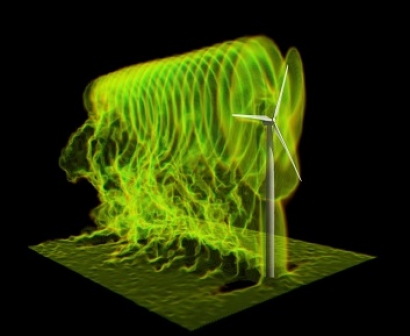
According to the researchers, a one percent improvement applied to all wind farms in the nation would generate the equivalent of $100 million in value. This new method, therefore, has the potential to generate $600 million in added wind power nationwide.
The team reported their findings in Wind Energy in December 2017 and Renewable Energy in December 2017.
A common way to model turbulence is through large eddy simulations. Several years ago, Stefano Leonardi and his research team created models that can integrate physical behavior across a wide range of length scales — from turbine rotors 100 meters long, to centimeters-thick tips of a blades — and predict wind power with accuracy using supercomputers.
"We developed a code to mimic wind turbines, taking into account the interference between the wake of the tower and the nacelle [the cover that houses all of the generating components in a wind turbine] with the wake of the turbine rotor," said Leonardi, associate professor of mechanical engineering and an author on the Wind Energy paper, which was selected for the cover.
Beyond the range of length scales, modeling the variability of wind for a given region at a specific time is another challenge. To address this, the team integrated their code with the Weather Research and Forecasting Model (WRF), a leading weather prediction model developed at the National Center for Atmospheric Research.
The growing power of computers allows Leonardi and his team to accurately model the wind field on a wind farm and the power production of each single turbine. Testing their model's results against data from a wind farm in North Texas, they saw a 90 percent agreement between their predictions and the turbine's efficiency. They will present their results at Torque 2018, a major wind energy research conference.
Wind doesn't simply flow smoothly in one direction. It contains turbulence and wakes which are magnified when turbines are grouped together as they are on a wind farm. Understanding how turbulence impacts energy generation is important to adjust the behavior of the turbines in real-time to reap maximum power.
Using their modeling capabilities, the researchers tested control algorithms used to manage the operation of dynamic systems at wind farms. This included the control algorithms known as extremum seeking control, a model-free way of getting the best performance out of dynamic systems when only limited knowledge of the system is known.
"We did a huge number of simulations to find out a way to filter turbulence out of the control scheme. This was the major challenge," Leonardi said.
With extremum seeking control, the system increases and reduces the rotational speed of a spinning turbine blade, all the while measuring the power, and calculating the gradient. This is repeated until the controller finds the optimal operating speed.
According to Leonardi, "There are many uncertainties in a real wind farm, so you cannot model everything. The extremum seeking control can find the optimum no matter if there is erosion or icing on the blades. It's very robust and works despite uncertainties in the system."
To test their new approach, the team ran virtual wind experiments using supercomputers at the TACC, including Stampede2 and Lonestar 5 – two of the most powerful in the world.
"The benefits of using high performance computing to create a virtual platform for doing analyses of proposed solutions for wind energy are enormous," said Mario Rotea, professor of mechanical engineering at UT Dallas, and site director of the National Science Foundation-supported Wind-Energy Science, Technology and Research (WindSTAR) Industry-University Cooperative Research Center (IUCRC).
While the application of extremum seeking control to wind farms is yet to be field tested, the UT Dallas team already applied the method to a single turbine at the National Renewable Energy Laboratory.
"The NREL test gave us experimental data supporting the value of extremum seeking control for wind power maximization," said Rotea. "The experimental results show that extremum seeking control increases the power capture by 8-12 percent relative to a baseline controller."
Given the encouraging experimental and computational results, the UT Dallas team is planning an experimental campaign involving a cluster of turbines in a wind farm.
The development of the fluid dynamics model for wind turbines was part of an international collaboration between four U.S. institutions (Johns Hopkins University, UT Dallas, Texas Tech and Smith College) and three European institutions (Technical University of Denmark, École polytechnique fédérale de Lausanne and Katholieke Universiteit Leuven) funded by the National Science Foundation through a Partnerships for International Research and Education (PIRE) award.
In addition, through the WindSTAR center, Leonardi, Rotea and colleagues at UTD collaborate with nine leading wind energy companies and equipment manufacturers. These companies are interested in adopting or commercializing the work.
In addition to developing the new turbulence algorithms and control strategies, members of the WindSTAR team have introduced methods to predict accurate results on less-powerful computers (work that appeared in the March 2018 issue of Wind Energy) and to determine how closely to place turbines to maximize profits, depending on the cost of land (presented at the 2018 Wind Symposium)
"The research allows us to optimize wind energy power production and increase the penetration of renewable energy in the grid," Leonardi said. "There will be more power generated by the same machines because we understand more about the flow physics in a wind farm, and for the same land use and deployment, we can get more energy."
Information provided by Texas Advanced Computer Center
Photo: The December 2017 cover image of Wind Energy, by University of Texas at Dallas researchers Christian Santoni Kenneth Carrasquillo Isnardo Arenas‐Navarro and Stefano Leonardi, was produced using Stampede2 at the Texas Advanced Computing Center.

